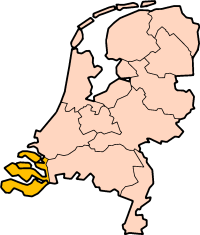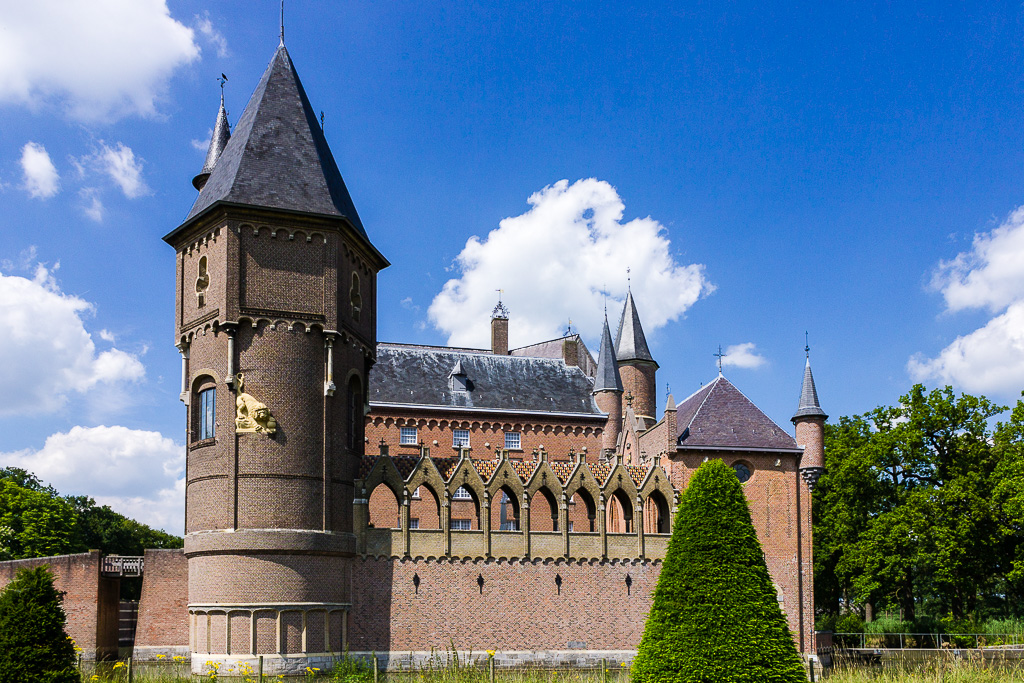|
Battle Of Zeeland
The Battle of Zeeland occurred on the Western Front during the early stages of the German assault on France and the Low Countries during World War II. Several Dutch and French units attempted to hold off the German onslaught by making a determined defense of the Dutch province of Zeeland. The battle lasted eight days and was a defeat for the French and Dutch forces defending the province. Defenses and troops in the province The province of Zeeland had received little attention from the Dutch government prior to the German invasion of the Low Countries in May 1940. On 10 May, the Germans launched their attack. In an attempt to raise morale amongst the Allies and to stem the tide of the German onslaught, several Dutch battalions—most notably the 14th Border Infantry Battalion—rapidly constructed defensive lines in Zeeland. The first—the Bathline (named after the nearby medieval fortress of Bath)—was little more than a tank barrier, slightly reinforced with 12 concrete ... [...More Info...] [...Related Items...] OR: [Wikipedia] [Google] [Baidu] |
Battle Of France
The Battle of France (french: bataille de France) (10 May – 25 June 1940), also known as the Western Campaign ('), the French Campaign (german: Frankreichfeldzug, ) and the Fall of France, was the Nazi Germany, German invasion of French Third Republic, France during the Second World War. On 3 September 1939, France French declaration of war on Germany (1939), declared war on Germany following the German invasion of Poland. In early September 1939, France began the limited Saar Offensive and by mid-October had withdrawn to their start lines. German armies German invasion of Belgium (1940), invaded Belgium, German invasion of Luxembourg, Luxembourg and German invasion of the Netherlands, the Netherlands on 10 May 1940. Fascist Italy (1922-1943), Italy entered the war on 10 June 1940 and attempted an Italian invasion of France, invasion of France. France and the Low Countries were conquered, ending land operations on the Western Front (World War II), Western Front until the Normandy l ... [...More Info...] [...Related Items...] OR: [Wikipedia] [Google] [Baidu] |
Bath, Zeeland
Bath is a small village and a former municipality in the Dutch province of Zeeland, lying on the north shore of the Western Scheldt. It is now located in the municipality of Reimerswaal, about 10 km southwest of Bergen op Zoom. History The village was first mentioned in 1325 as "insula de Boestenbare dicta". The current name refers to the Bad Creek (compare: bath). According to the 19th-century historian A.J. van der Aa, the former village of Bath was hit by floods several times in the 16th century: in 1530, 1532, 1536 and 1539. After these floods, only the church tower of the village was left, but it too had disappeared by the 19th century. In 1773, a part of the area was reclaimed from the sea again, and a fort, Fort Bath, was built in 1785 to protect the ships who collected the toll for passing ships. A small hamlet was built inside the fort; this became the new village of Bath. The structure contained a square fort with three bastions surrounded by a moat. In 1809, it ... [...More Info...] [...Related Items...] OR: [Wikipedia] [Google] [Baidu] |
Moerdijk
Moerdijk () is a municipality and a town in the South of the Netherlands, in the province of North Brabant. History The municipality of Moerdijk was founded in 1997 following the merger of the municipalities of Fijnaart en Heijningen, Klundert, Standdaarbuiten, Willemstad, and Zevenbergen. At that time the new municipality was called Zevenbergen. The name changed to Moerdijk on 1 April 1998. * List of mayors of Moerdijk Population centres Topography ''Dutch Topographic map of the municipality of Moerdijk, June 2015'' The village of Moerdijk The village of Moerdijk is one of the smaller villages of the municipality. Population as of 2002 is 1,205. ''Moerdijk'' is however a well-known name in the Netherlands, because of the large Moerdijk industrial area, with a large power plant, and because of the well-known Moerdijk bridges (highway and railway bridges) across the Hollands Diep. This was the last bridge available for the retreat from the vital Scheldt Estuary of ... [...More Info...] [...Related Items...] OR: [Wikipedia] [Google] [Baidu] |
KW-line
The Koningshooikt—Wavre Line, abbreviated to KW Line (french: Ligne KW; nl, KW-stelling) and often known as the Dyle Line after the Dijle (Dyle) river, was a -long fortified line of defence prepared by the Belgian Army between Koningshooikt ( Province of Antwerp) and Wavre ( Province of Brabant) which was intended to protect Brussels from a possible German invasion. Construction on the KW Line began in September 1939 after World War II had begun but while Belgium itself remained a neutral state. It was subsequently extended southwards from Wavre towards Namur ( Province of Namur). The line itself consisted of bunkers, anti-tank ditches, and barricades including so-called Cointet-elements and played a key role in Allied strategy during the German invasion of Belgium in May 1940. However, its role in the actual fighting was ultimately minimal. In 2009 an inventory of surviving emplacements was begun. Background In October 1936, Belgium abandoned its previous military alli ... [...More Info...] [...Related Items...] OR: [Wikipedia] [Google] [Baidu] |
North Brabant
North Brabant ( nl, Noord-Brabant ; Brabantian: ; ), also unofficially called Brabant, is a province in the south of the Netherlands. It borders the provinces of South Holland and Gelderland to the north, Limburg to the east, Zeeland to the west, and the Flemish provinces of Antwerp and Limburg to the south. The northern border follows the Meuse westward to its mouth in the Hollands Diep strait, part of the Rhine–Meuse–Scheldt delta. North Brabant has a population of 2,562,566 as of November 2019. Major cities in North Brabant are Eindhoven (pop. 231,642), Tilburg (pop. 217,259), Breda (pop. 183,873) and its provincial capital 's-Hertogenbosch (pop. 154,205). History The Duchy of Brabant was a state of the Holy Roman Empire established in 1183 or 1190. It developed from the Landgraviate of Brabant and formed the heart of the historic Low Countries, part of the Burgundian Netherlands from 1430 and of the Habsburg Netherlands from 1482, until it was spl ... [...More Info...] [...Related Items...] OR: [Wikipedia] [Google] [Baidu] |
Bergen Op Zoom
Bergen op Zoom (; called ''Berrege'' in the local dialect) is a municipality and a city located in the south of the Netherlands. Etymology The city was built on a place where two types of soil meet: sandy soil and marine clay. The sandy soil pushed against the marine clay, accumulating and forming hills over several centuries. People called those hills the ''Brabantse Wal'', literally meaning "ramparts of Brabant". ''Zoom'' refers to the border of these ramparts and ''bergen'' in Dutch means mountains or hills. The name has nothing to do with the little channel, the ‘Zoom’, which was later built through Bergen op Zoom. History Bergen op Zoom was granted city status probably in 1212. In 1287 the city and its surroundings became a lordship as it was separated from the lordship of Breda. The lordship was elevated to a margraviate in 1559. Several noble families, including the House of Glymes, ruled Bergen op Zoom in succession until 1795, although the title was only nom ... [...More Info...] [...Related Items...] OR: [Wikipedia] [Google] [Baidu] |
Luftwaffe
The ''Luftwaffe'' () was the aerial-warfare branch of the German '' Wehrmacht'' before and during World War II. Germany's military air arms during World War I, the '' Luftstreitkräfte'' of the Imperial Army and the '' Marine-Fliegerabteilung'' of the Imperial Navy, had been disbanded in May 1920 in accordance with the terms of the 1919 Treaty of Versailles which banned Germany from having any air force. During the interwar period, German pilots were trained secretly in violation of the treaty at Lipetsk Air Base in the Soviet Union. With the rise of the Nazi Party and the repudiation of the Versailles Treaty, the ''Luftwaffe''s existence was publicly acknowledged on 26 February 1935, just over two weeks before open defiance of the Versailles Treaty through German rearmament and conscription would be announced on 16 March. The Condor Legion, a ''Luftwaffe'' detachment sent to aid Nationalist forces in the Spanish Civil War, provided the force with a valuable testing ... [...More Info...] [...Related Items...] OR: [Wikipedia] [Google] [Baidu] |
Vlissingen
Vlissingen (; zea, label= Zeelandic, Vlissienge), historically known in English as Flushing, is a municipality and a city in the southwestern Netherlands on the former island of Walcheren. With its strategic location between the Scheldt river and the North Sea, Vlissingen has been an important harbour for centuries. It was granted city rights in 1315. In the 17th century Vlissingen was a main harbour for ships of the Dutch East India Company (VOC). It is also known as the birthplace of Admiral Michiel de Ruyter. Vlissingen is mainly noted for the yards on the Scheldt where most of the ships of the Royal Netherlands Navy (''Koninklijke Marine'') are built. Geography The municipality of Vlissingen consists of the following places: * City: Vlissingen * Villages: Oost-Souburg, Ritthem, and West-Souburg * Hamlet: Groot-Abeele History The fishermen's hamlet that came into existence at the estuary of the Schelde around AD 620 has grown over its 1,400-year history into the thir ... [...More Info...] [...Related Items...] OR: [Wikipedia] [Google] [Baidu] |
68th Infantry Division (France)
The 68th Infantry Division (french: 68e Division d'Infanterie, 68e DI) was a French Army formation during the First and Second World Wars. First World War During the war of 1914 to 1918, the division comprised: *206th Infantry Regiment *212nd Infantry Regiment (to February 1917) *234th Infantry Regiment *257th Infantry Regiment (to June 1916) *323rd Infantry Regiment (to June 1916) *344th Infantry Regiment *A battalion of the 73rd Territorial Infantry Regiment (from July 1917) It was part of the French 2nd, 3rd, 7th, 11th, 13th, 14th, 15th, 16th, 17th, 20th, 21st, 35th, 39th and 40th Corps, during which it participated in the Battle of Morhange, the Battle of Grand Couronne, the Battle of Verdun, the Second Battle of the Marne, and the Meuse-Argonne Offensive. At various times, the Division was part of the First, Second, Third, Fourth, Fifth, Sixth, Seventh, Eighth, and Tenth French Armies. Second World War During the Battle of France in May 1940, the division con ... [...More Info...] [...Related Items...] OR: [Wikipedia] [Google] [Baidu] |
Mortar (weapon)
A mortar is usually a simple, lightweight, man-portable, muzzle-loaded weapon, consisting of a smooth-bore (although some models use a rifled barrel) metal tube fixed to a base plate (to spread out the recoil) with a lightweight bipod mount and a sight. They launch explosive shells (technically called bombs) in high-arcing ballistic trajectories. Mortars are typically used as indirect fire weapons for close fire support with a variety of ammunition. History Mortars have been used for hundreds of years. The earliest mortars were used in Korea in a 1413 naval battle when Korean gunsmiths developed the ''wan'gu'' (gourd-shaped mortar) (완구, 碗口). The earliest version of the ''wan'gu'' dates back to 1407. Choi Hae-san (최해산, 崔海山) (1380–1443), the son of Choe Mu-seon (최무선, 崔茂宣) (1325–1395), is generally credited with inventing the ''wan'gu''. In the Ming dynasty, general Qi Jiguang recorded the use of a mini cannon called the Hu dun pao that ... [...More Info...] [...Related Items...] OR: [Wikipedia] [Google] [Baidu] |




